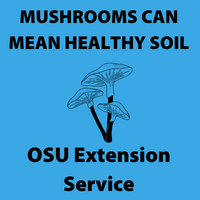Why are mushrooms popping up in my yard?
By Georgianne Messina
Note:
This article will not identify poisonous versus edible fungi. Identification of mushrooms should be done by experts -UCCE Master Gardeners are not mycologists either professionally or as hobbyists. Mis-identification of mushrooms has had lethal effects on humans and pets.
***Correction 2/2/23 - Mushrooms aid in the decomposition of matter. They secrete (not excrete) enzymes that begin the process of decomposition.
This winter, there seems to be no avoidance in spotting a multitude of mushrooms growing in yards, park trails, and occasionally in houseplants. Are we being invaded by UFOs (unidentified fungal objects) more than last year? It seems like it. Why? Are these mushrooms harmful to people and pets? Should I get rid of them and how can I dispose of them in a safe manner?
Why are there so many mushrooms this year?
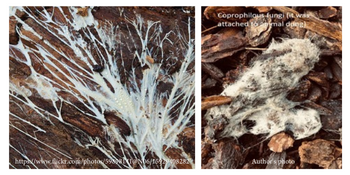
Mushrooms – good or bad?
The appearance of mushrooms in a garden or yard brings anxiety to many. Though wild mushrooms can be harmful, if ingested, they also are essential supporters of plants such as native oaks, pines, and conifers. They may serve as indicators of plant or soil health.
Are Mushrooms Beneficial?
While mushrooms are beneficial for many reasons, we will focus on just two in this blog. Please note that mushrooms and fungi will be used interchangeably.
- Mushrooms aid in the decomposition of matter. They secrete enzymes that begin the process of decomposition. In fact, they sprout up in soils that are rich in organic matter – indicating healthy soil. You will see mushrooms in all sorts of decaying materials … compost, decaying tree roots, leaf litter, old wood, especially when moisture/dampness is present. Mushrooms are often seen at the base of a tree and can indicate that the tree is not doing well. Those mushrooms are likely a common species found in our area, the Armillaria (often called honey fungus), one of the largest living organisms in the world. It is a parasitic fungus that feeds on living and dead plant material.
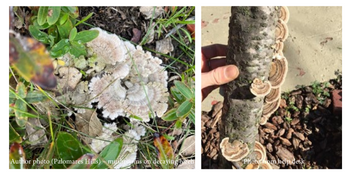 Photo submitted to our Help Desk-Author photo (Palomares Hills) – mushrooms on decaying birch roots
Photo submitted to our Help Desk-Author photo (Palomares Hills) – mushrooms on decaying birch roots - The relationship between fungi and mycorrhizae are critical to the optimal growth of plants. Fungal hyphae and plant roots working together are called mycorrhizae. Mycorrhizae in the soil has been found to suppress soil-borne pathogens and protect plants from root diseases.
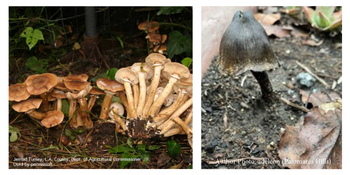 R Photo:Jerrold Turney, Los Angeles County; Dept. of Agricultural Commissioner L Photo: adeleon (Palomares Hills)
R Photo:Jerrold Turney, Los Angeles County; Dept. of Agricultural Commissioner L Photo: adeleon (Palomares Hills)
Are Mushrooms Harmful?
Despite the beneficial attributes of fungi to your soil and plants, they are often harmful to humans and pets when eaten. Several varieties of mushrooms are toxic, but very few are actually deadlyThis article will not identify poisonous versus edible. Identification of mushrooms should be done by expert mycologists. UCCE Master Gardeners are not mycologists either professionally or as hobbyists. The misidentification of mushrooms has had lethal effects on humans and pets.
As East Bay Regional Parks (EBRP) website points out: “The Bay Area is home to two of the world's most toxic mushrooms. Amanita phalloides (the Death Cap) and Amanita ocreata (the Western Destroying Angel). Both are robust, handsome mushrooms that grow near oak trees, and both contain lethal toxins.” The article goes on to say that these two mushroom species are responsible for most of the mushroom poisonings; however, Galerina and Lepiota species are poisonous as well and are found in the Bay Area."
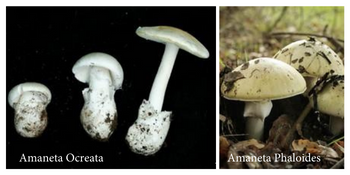
Text and photos by Trent Pearce, Naturalist, Tilden Nature Area
More photos can be found on the EBRP website.
Erring on the side of caution seems to be the best way to approach an unidentified, wild mushroom.
How do I safely remove and dispose of a UFO (unidentified fungal object)?
To remove the mushrooms, carefully rake them up in a small pile or dislodge them manually (wear nitrile gloves). Place the mushrooms in a paper or compostable bag and place it in the green bin. Discard the gloves, wash your hands after this activity, keep pets and children away from the area while you are working. Again, best to err on the side of caution since you do not know the type of mushroom you are dealing with.
Are Mushrooms Harmful to Children?
Wild mushrooms certainly have the potential to be harmful. From November 2016 through January 2018, there were about 1038 cases of mushroom poisoning. Of those cases, 433 (41.7%) were children under six years of age*. Eating poisonous mushrooms can cause abdominal pain, cramping, vomiting, diarrhea, liver damage, or death. Anyone who develops symptoms after eating wild mushrooms should seek immediate medical attention. People who develop these symptoms should immediately contact the California Poison Control System at (800) 222-1222 or their health care provider
Are Mushrooms Harmful to Pets?
Again, wild mushrooms DO have the potential to be harmful to pets. Dogs are affected differently than cats. Some mushrooms have a fishy odor which attracts pets.
According to the UC Davis School of Veterinary Medicine,” It is safest to assume that all wild mushrooms that your dog encounters are toxic.“ If your pet may have been poisoned by mushrooms, try to get a sample of the same mushroom or mushrooms from where they were found. This will help aid in identification.
Place any available material in a paper bag or waxed paper, not plastic, and refrigerate until it can be examined. Note where the mushrooms were collected in case the mushrooms may have been contaminated by uptake of pesticides or heavy metals from lawns, roadsides, or industrial areas.
Symptoms are delayed after ingestion (up to 12+hours). Do not wait for the mushroom to be identified or wait for symptoms to start., call your veterinarian or contact an emergency veterinary hospital as rapid treatment is critical.
Resources:
Why are mushroom growing in my lawn?
UC IPM Pest Note: Ammilaria Root Rot
UC IPM Wood Decay Fungi in Landscape Trees
Still need help?
Email us at acmg@ucanr.edu. Or contact us through our website
More resources:
Mushrooms in lawns
http://ipm.ucanr.edu/PMG/PESTNOTES/pn74100.html
Armillaria Root Rot Management
Armillaria Root Rot Management Guidelines--UC IPM
https://ucanr.edu/blogs/uccemgsantaclaranews/index.cfm?tagname=Mushrooms
* California Department of Public Health - Urges Caution When Collecting Wild Mushrooms
https://www.cdph.ca.gov/Programs/OPA/Pages/NR18-007.aspx
East Bay Regional Parks - Toxic Mushrooms
https://www.ebparks.org/safety/trails/toxic-mushrooms
California Poison Control System
https://calpoison.org/news/deadly-mushrooms
Stanislaus County Master Gardeners - Magical Mushrooms
https://ucanr.edu/blogs/blogcore/postdetail.cfm?postnum=51028
Mycological Society of San Francisco
Toxic Fungi of North America
https://www.mykoweb.com/TFWNA/Toxic_Fungi_of_Western_NA.pdf
Mushroom Poisoning in Dogs
https://www.aspcapro.org/resource/mushroom-poisoning-dogs
https://namyco.org/mushroom_poisonings_in_dogs_an.php
Mushrooms may mean healthy soil
https://extension.oregonstate.edu/news/mushrooms-can-mean-healthy-soil




